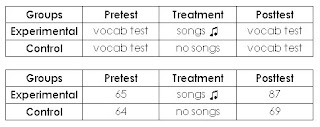Experimental research is conducted to determine cause and effect. For example, the topic of your research is:
The effects of using songs in the teaching of vocabulary on the students' vocabulary size.
You want to find out whether the use of songs
The design of the experimental research is like this:

You have two groups, experimental and control groups. You give both of them a pretest, which is a vocabulary test, at the beginning of the semester. Make sure that both groups are equal. After that, you teach vocabulary to both groups for one semester. You teach the experimental group using songs (treatment), while the control groups is taught vocabulary without using songs. At the end of the semester you give both groups a posttest, which is exactly the same as the pretest, and analyze the means of the posttest using t-test to find out whether there is a significant difference between teaching vocabulary using songs and without using songs.
There are 3 characteristics of experimental research.
1. Control
The control is applied to the condition of the subjects.
You have an experimental group, and you have a control group to make sure the treatment makes (or doesn’t make) a difference to the experimental group. You control the condition of both groups. Both should:
- be of the same age
- have equal ability
- consist of equal number of males & females
- etc.
This is not a negative term in experimental research!
It simply means the manipulation of the independent variable.
The independent variable of the research problem "The effects of using songs on the students’ vocabulary size" is the use of songs. You manipulate this variable by doing this:
- The experimental group is taught using songs.
- The control group is taught without using songs.
3. Observation
This is not a qualitative observation!
It simply means you observe the difference between the experimental and control groups after you conduct the experiment. You have to do statistical analysis (t-test) to find out whether there is a significant difference between the two groups.
You need two processes to select the sample of your experimental research.
1. Random sampling: selecting the sample from the population randomly, e.g.
10 classes of eight graders (population)

2 classes of eight graders (sample)
2 classes of eight graders (sample)
2. Random assignment: assigning the sample into 2 groups (experimental & control) randomly, e.g.
Class C
Class F
The above processes can be described in the chart below.



No comments:
Post a Comment
Note: Only a member of this blog may post a comment.